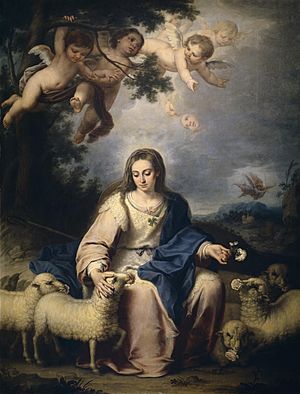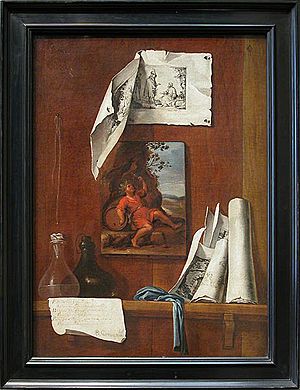Bernardo Germán de Llórente facts for kids
Bernardo Germán de Llórente (born 1685, died 1757) was a Spanish painter from a long time ago. He lived and worked in a city called Seville. Bernardo was a big fan of another famous painter named Murillo. He became well-known for his paintings of the Virgin Mary, which were often used for religious devotion. He also painted pictures of people and amazing still lifes that looked super real, a style called trompe-l'œil.
Contents
Life of a Painter
Bernardo Germán de Llórente was born and passed away in Seville. He probably first learned to paint from his father. Later, he studied with Cristóbal López. Cristóbal López was a painter who followed the style of Murillo. Bernardo learned how to paint in a way that looked very similar to Murillo's work.
The Divine Shepherdess
A priest named Father Isidoro de Sevilla asked Bernardo to paint a special picture. It was a "Virgin in shepherd dress." This painting made Bernardo very famous! Soon, many people wanted similar paintings. He painted the Virgin Mary as a shepherdess so often that people called him "the painter of shepherdesses."
His paintings were so much like Murillo's that one of his works, the Divine Shepherdess at the Prado Museum, was thought to be by Murillo for many years. It was hard to tell the difference!
Painting for the Queen
Around 1730, the Spanish royal family was staying in Seville. Queen Isabel Farnese asked Bernardo to paint a portrait of her son, Don Philip. Don Philip was about 10 years old at the time. The painting shows him wearing fancy clothes from that period. He has a red coat with silver designs and special sashes.
This portrait shows that Bernardo was influenced by another painter, Jean Ranc. Jean Ranc was a court painter for the Bourbon royal family. Bernardo had the chance to meet him while he was in Seville.
The Queen loved the portrait so much that she gave Bernardo many gifts. The King, Philip V, even asked him to come to Madrid to be a court painter. But Bernardo said no! He preferred to live an independent life and paint on his own. In 1735, he became a member of the Academia Real de Bellas Artes de San Fernando.
Amazing Still Lifes
Bernardo was also known for his trompe-l'œil still lifes. This is a French term that means "trick the eye." These paintings make flat objects look like they are real and sticking out from the canvas. This style was very popular in Spain at the time.
One example is his painting called Wine or the Allegory of taste at the Louvre museum. This painting shows different things related to wine and taste.
See also
 In Spanish: Bernardo Lorente Germán para niños
In Spanish: Bernardo Lorente Germán para niños
- Lorenzo Quiros (a pupil and imitator of Murillo)



